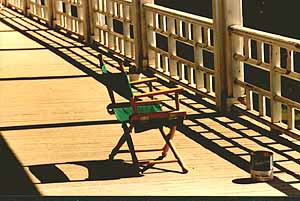
WAWONA
JOURNAL
by TOM BOPP
September, 2000
HOLLYWOOD INGENUITY TRANSFORMS YOSEMITE LANDMARK INTO NAZI MILITARY CAMP FOR REALISTIC SETTING IN "36 HOURS"
From a 1964 MGM press packet for the movie "36 Hours", courtesy of Dean Schenk
Transforming a United States National Park into the Black Forest of Bavaria is only part of a day’s work for a movie company on location. But it can be baffling to the unsuspecting tourist.
Yosemite’s Wawona Hotel on the Chowchilla Mountain and Inspiration Point Road has been the haven of weary travelers for the past 100 years. Rooms are at a premium. The hotel’s vista-windowed dining room is noted across the continent for gourmet menus. But recently, no one ventured to ask for overnight sanctuary or even a sandwich. The reason was due to a sign which had been stretched across Wawona’s Victorian facade, reading: UNITED STATES MILITARY HOSPITAL.
This is the illusion of movie-making. It is illusion within illusion--the placing of an Allied Army Hospital into an alleged Nazi military camp where there actually is a stately Yosemite resort hotel. The camouflage was for the new Metro-Goldwyn-Mayer picture, "36 Hours," a unique and exciting suspense-drama, starring James Garner, Eva Marie Saint, Rod Taylor, and Werner Peters, and revolving around an incident which occurred in the fateful hours prior to D-Day.
The illusion created by an array of pseudo-doctors, patients, nurses and military personnel is only a natural occurrence when a film company like MGM’s "36 Hours" transports actors, directors, cameramen, construction crew, a company of 160 Hollywood extras and a half-million pounds of equipment from a motion picture studio into the Big Trees of Northern California.
Twenty-eight vehicles and sixteen drivers moved the equipment, which included two ten-ton truck hauling two ten-ton trailers packed with 65,000 pounds of materials. Three buses with a seating capacity of 42 passengers each; two 1400-amp generators, a 600-amp generator, two ambulances, three station wagons, two ten-passenger stretchouts, five passenger cars and eight military vehicles of World War II vintage were part of the space-age caravan.
Personnel of the film crew and extras commandeered the Wawona Hotel, whose lower floors were converted into dressing rooms, wardrobe storage and make-up salons. The picture’s stars and Director George Seaton lived in redwood cabins huddled among the Big Trees, two miles distant from the main lodgings. A shuttle service on a fifteen minute time schedule provided transportation back and forth to work and to meals.
Pastoral Setting
The beauty of the surroundings of the cabins occupied by the stars made up for the inconvenience of the secluded location. Squirrels chased bluejays through the cabin doors and deer peremptorily pushed open windows to demand early morning handouts. Should anyone elect to walk the two miles to the hotel (a feat which James Garner insisted on each dawn) he was tripped by chickadees, wrens, mud swallows and baby deer.
Neither deer, birds, squirrels nor bear feared man. However, when the rump of a 600-pound brown bear came into camera view one early morning, man feared beast. When the bear made no attempt to leave but merely made himself comfortable and remained to watch the movie-making, work resumed as usual. Any ego build-up of stars was shattered when it turned out that the scene Director Seaton was shooting with Garner, Eva Marie Saint and Rod Taylor happened to be located at the bear’s favorite Yosemite site--the park dump! When the company moved out, the bear moved in and ate his dinner.
Despite the beauty of the surroundings, the grandeur of the cascading falls, the froth-churned Merced River and the Tuolomne Meadows bursting with wild flowers, a film location can pose a number of problems for a company of such proportions as the "36 Hours" contingent.
First and foremost is weather. It snowed, rained, hailed, sleeted and was sunny, all within a fifteen-minute period. Food is another poser. The Wawona chef prepared his palate-titillating menus, offering a variety of choices, for the first three days until 120 out of 160 continued to order shrimp cocktails and either broiled steak--rare--or lobster tails.
Then there’s the solemn oath taken by any and every motion picture company which enters a National Park, doubly so when a site like the Wawona is the locale. In all its one-hundred years, no movie company previously had trod its soil. Any evidence that Yosemite was ever transformed into Bavaria, or the Wawona Hotel into an Allied Military Hospital had to be totally wiped out 24 hours after the "36 Hours" exodus. Compliance with this condition was the only way Producer William Perlberg could get into the National Park area for his picture.